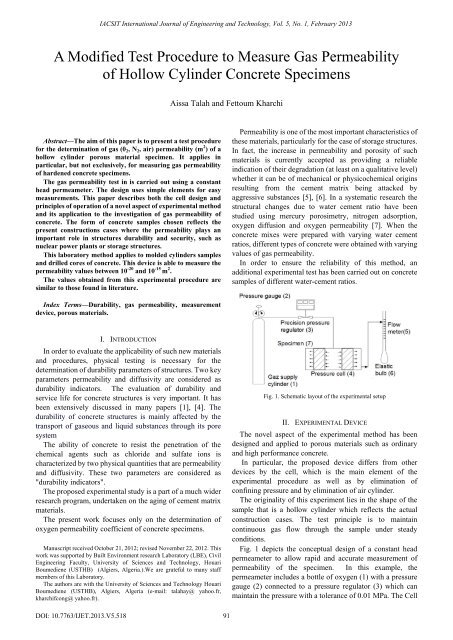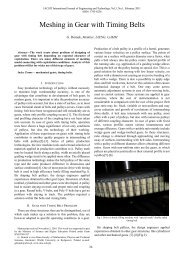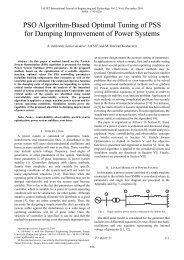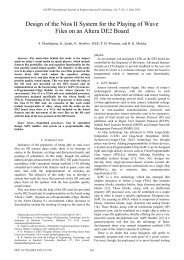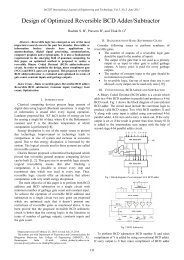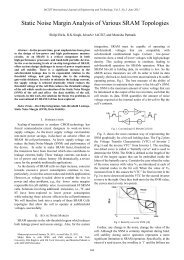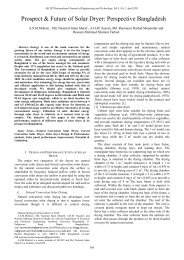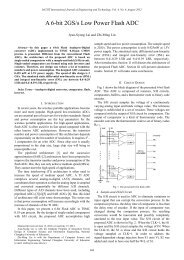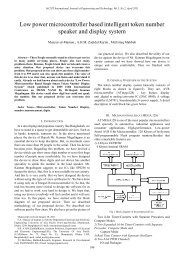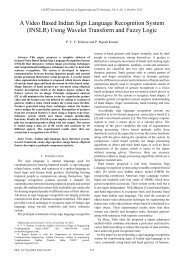A Modified Test Procedure to Measure Gas Permeability of ... - IJET
A Modified Test Procedure to Measure Gas Permeability of ... - IJET
A Modified Test Procedure to Measure Gas Permeability of ... - IJET
Create successful ePaper yourself
Turn your PDF publications into a flip-book with our unique Google optimized e-Paper software.
IACSIT International Journal <strong>of</strong> Engineering and Technology, Vol. 5, No. 1, February 2013<br />
A <strong>Modified</strong> <strong>Test</strong> <strong>Procedure</strong> <strong>to</strong> <strong>Measure</strong> <strong>Gas</strong> <strong>Permeability</strong><br />
<strong>of</strong> Hollow Cylinder Concrete Specimens<br />
Aissa Talah and Fet<strong>to</strong>um Kharchi<br />
<br />
Abstract—The aim <strong>of</strong> this paper is <strong>to</strong> present a test procedure<br />
for the determination <strong>of</strong> gas (0 2 , N 2 , air) permeability (m 2 ) <strong>of</strong> a<br />
hollow cylinder porous material specimen. It applies in<br />
particular, but not exclusively, for measuring gas permeability<br />
<strong>of</strong> hardened concrete specimens.<br />
The gas permeability test in is carried out using a constant<br />
head permeameter. The design uses simple elements for easy<br />
measurements. This paper describes both the cell design and<br />
principles <strong>of</strong> operation <strong>of</strong> a novel aspect <strong>of</strong> experimental method<br />
and its application <strong>to</strong> the investigation <strong>of</strong> gas permeability <strong>of</strong><br />
concrete. The form <strong>of</strong> concrete samples chosen reflects the<br />
present constructions cases where the permeability plays an<br />
important role in structures durability and security, such as<br />
nuclear power plants or s<strong>to</strong>rage structures.<br />
This labora<strong>to</strong>ry method applies <strong>to</strong> molded cylinders samples<br />
and drilled cores <strong>of</strong> concrete. This device is able <strong>to</strong> measure the<br />
permeability values between 10 -20 and 10 -15 m 2 .<br />
The values obtained from this experimental procedure are<br />
similar <strong>to</strong> those found in literature.<br />
<strong>Permeability</strong> is one <strong>of</strong> the most important characteristics <strong>of</strong><br />
these materials, particularly for the case <strong>of</strong> s<strong>to</strong>rage structures.<br />
In fact, the increase in permeability and porosity <strong>of</strong> such<br />
materials is currently accepted as providing a reliable<br />
indication <strong>of</strong> their degradation (at least on a qualitative level)<br />
whether it can be <strong>of</strong> mechanical or physicochemical origins<br />
resulting from the cement matrix being attacked by<br />
aggressive substances [5], [6]. In a systematic research the<br />
structural changes due <strong>to</strong> water cement ratio have been<br />
studied using mercury porosimetry, nitrogen adsorption,<br />
oxygen diffusion and oxygen permeability [7]. When the<br />
concrete mixes were prepared with varying water cement<br />
ratios, different types <strong>of</strong> concrete were obtained with varying<br />
values <strong>of</strong> gas permeability.<br />
In order <strong>to</strong> ensure the reliability <strong>of</strong> this method, an<br />
additional experimental test has been carried out on concrete<br />
samples <strong>of</strong> different water-cement ratios.<br />
Index Terms—Durability, gas permeability, measurement<br />
device, porous materials.<br />
I. INTRODUCTION<br />
In order <strong>to</strong> evaluate the applicability <strong>of</strong> such new materials<br />
and procedures, physical testing is necessary for the<br />
determination <strong>of</strong> durability parameters <strong>of</strong> structures. Two key<br />
parameters permeability and diffusivity are considered as<br />
durability indica<strong>to</strong>rs. The evaluation <strong>of</strong> durability and<br />
service life for concrete structures is very important. It has<br />
been extensively discussed in many papers [1], [4]. The<br />
durability <strong>of</strong> concrete structures is mainly affected by the<br />
transport <strong>of</strong> gaseous and liquid substances through its pore<br />
system<br />
The ability <strong>of</strong> concrete <strong>to</strong> resist the penetration <strong>of</strong> the<br />
chemical agents such as chloride and sulfate ions is<br />
characterized by two physical quantities that are permeability<br />
and diffusivity. These two parameters are considered as<br />
"durability indica<strong>to</strong>rs".<br />
The proposed experimental study is a part <strong>of</strong> a much wider<br />
research program, undertaken on the aging <strong>of</strong> cement matrix<br />
materials.<br />
The present work focuses only on the determination <strong>of</strong><br />
oxygen permeability coefficient <strong>of</strong> concrete specimens.<br />
Manuscript received Oc<strong>to</strong>ber 21, 2012; revised November 22, 2012. This<br />
work was supported by Built Environment research Labora<strong>to</strong>ry (LBE), Civil<br />
Engineering Faculty, University <strong>of</strong> Sciences and Technology, Houari<br />
Boumediene (USTHB) (Algiers, Algeria.).We are grateful <strong>to</strong> many staff<br />
members <strong>of</strong> this Labora<strong>to</strong>ry.<br />
The authors are with the University <strong>of</strong> Sciences and Technology Houari<br />
Boumediene (USTHB), Algiers, Algeria (e-mail: talahay@ yahoo.fr,<br />
kharchifcong@ yahoo.fr).<br />
Fig. 1. Schematic layout <strong>of</strong> the experimental setup<br />
II. EXPERIMENTAL DEVICE<br />
The novel aspect <strong>of</strong> the experimental method has been<br />
designed and applied <strong>to</strong> porous materials such as ordinary<br />
and high performance concrete.<br />
In particular, the proposed device differs from other<br />
devices by the cell, which is the main element <strong>of</strong> the<br />
experimental procedure as well as by elimination <strong>of</strong><br />
confining pressure and by elimination <strong>of</strong> air cylinder.<br />
The originality <strong>of</strong> this experiment lies in the shape <strong>of</strong> the<br />
sample that is a hollow cylinder which reflects the actual<br />
construction cases. The test principle is <strong>to</strong> maintain<br />
continuous gas flow through the sample under steady<br />
conditions.<br />
Fig. 1 depicts the conceptual design <strong>of</strong> a constant head<br />
permeameter <strong>to</strong> allow rapid and accurate measurement <strong>of</strong><br />
permeability <strong>of</strong> the specimen. In this example, the<br />
permeameter includes a bottle <strong>of</strong> oxygen (1) with a pressure<br />
gauge (2) connected <strong>to</strong> a pressure regula<strong>to</strong>r (3) which can<br />
maintain the pressure with a <strong>to</strong>lerance <strong>of</strong> 0.01 MPa. The Cell<br />
DOI: 10.7763/<strong>IJET</strong>.2013.V5.518<br />
91
IACSIT International Journal <strong>of</strong> Engineering and Technology, Vol. 5, No. 1, February 2013<br />
(4) containing the specimen is connected in series with the<br />
regula<strong>to</strong>r and the flowmeter (5) by a flexible tube.<br />
concrete specimens is given by the following equations.<br />
K<br />
2<br />
(2. Q.<br />
P . L.<br />
)/( P<br />
2 P A<br />
(1)<br />
a atm<br />
atm)<br />
In this present case; A is given by<br />
A <br />
R2<br />
R1<br />
2 2<br />
(2. . h.<br />
R.<br />
dR) / L .<br />
h.(<br />
R R ) / L (2)<br />
The apparent permeability relation becomes<br />
2 2<br />
2 2<br />
Ka (2. Q.<br />
Patm<br />
. L.<br />
)/( P Patm<br />
) .<br />
h.(<br />
R2<br />
R1<br />
)/<br />
L (3)<br />
2<br />
1<br />
K<br />
a<br />
2 2 2 2<br />
( 2. Q.<br />
Patm<br />
)( R2 R1<br />
) /( P Patm<br />
) .<br />
h.(<br />
R2<br />
R1<br />
) (4)<br />
where: see Fig. 3.<br />
Fig. 2. Schematic representation <strong>of</strong> the cell.<br />
Fig. 2 shows the cell section, consisting <strong>of</strong> two cylindrical<br />
plates (1, 2) <strong>of</strong> the same diameter. One plate is mobile while<br />
the other is fixed. The <strong>to</strong>p plate is fitted with a valve (3) <strong>to</strong><br />
evacuate air occluded in the hollow cylindrical test-specimen.<br />
These plates are covered with a rubber sealing strip (4) <strong>to</strong><br />
ensure a good seal between the two cylindrical plates (1, 2)<br />
and the specimen (5). The test specimen (5) is surrounded by<br />
a plexiglas cell (6) sealed and connected laterally <strong>to</strong> flexible<br />
tube (7) and <strong>to</strong> the flowmeter (5). Flowmeter includes an<br />
elastic bulb (6) with soapy water. By exerting pressure on the<br />
bulb, a bubble rises, driven by the flow <strong>of</strong> outgoing gas and<br />
the graduated tube, permitting then <strong>to</strong> measure the gas flow.<br />
The input pressure can be chosen between 0.1 MPa and 0.8<br />
MPa with an accuracy <strong>of</strong> 0.01 MPa.<br />
This experimental device may be used for the following<br />
tests:<br />
Measuring a single pressure value (typically 0.2 MPa) <strong>to</strong><br />
evaluate the apparent permeability <strong>of</strong> the material (K a );-<br />
Measuring more than two successive pressure (typically 0.2<br />
MPa, 0.3 MPa and 0.5 MPa) with calculation <strong>of</strong> the intrinsic<br />
permeability <strong>of</strong> the material (k i ) [8].<br />
The specimens <strong>of</strong> variable diameters required for<br />
measurements <strong>of</strong> permeability are molded and cored<br />
cylindrical concrete specimens. The proposed cell can be<br />
manufactured <strong>to</strong> fit samples <strong>of</strong> any dimension. The cell may<br />
also be used for any other type <strong>of</strong> solid porous material.<br />
The permeameter must be installed in an air-conditioned<br />
room (T = 20 ± 1°C and relative humidity = 65 ± 5%).<br />
Fig. 3. Specimen.<br />
h= specimen thickness (m);<br />
A=cross-sectional Area (m 2 );<br />
L=R 2 -R 1 : length <strong>of</strong> the section <strong>of</strong> sample crossed by the<br />
flow (m);<br />
R 1 = inner radius;<br />
R 2 = outer radius;<br />
=gas dynamic viscosity (Ns/m 2 ).<br />
For oxygen, =20, 2.10 -6 Ns/m 2 at 20°C.<br />
Intrinsic permeability (K i ) is defined by Klinkenberg [10]<br />
as the y-intercept <strong>of</strong> the line connecting the permeability and<br />
the inverse <strong>of</strong> the average pressure P moy , with<br />
P moy = (P atm + P) / 2.<br />
The method used for determining the intrinsic permeability<br />
coefficient (K i ) , consists <strong>of</strong> measuring K a at different<br />
pressures and plotting it against the inverse <strong>of</strong> the mean<br />
pressure. The intrinsic permeability value can be a better<br />
parameter for characterization <strong>of</strong> a concrete for durability<br />
compared <strong>to</strong> the traditional Darcy's coefficient <strong>of</strong><br />
permeability, as it is independent <strong>of</strong> the fluid properties and<br />
the applied pressure gradient. It is hence, a characteristic <strong>of</strong><br />
the porous medium alone. It may allow us <strong>to</strong> make a better<br />
comparison <strong>of</strong> values obtained under different experimental<br />
conditions [8], [9].<br />
III. GAS PERMEABILITY MEASUREMENTS<br />
The test consists <strong>of</strong> maintaining the test specimen at a<br />
constant pressure <strong>of</strong> oxygen gas. The apparent permeability<br />
(k a ), in m 2 , is calculated at constant pressure using the<br />
Hagen-Poiseuille expression for a compressible fluid.<br />
Since gases are compressible, the inlet pressure P (applied<br />
test pressure (absolute)) at which the flow rate (Q) is<br />
measured must be taken in<strong>to</strong> account in addition <strong>to</strong> the outlet<br />
pressure P atm (atmospheric pressure). All pressures are<br />
absolute values expressed in N/m 2 [9]. The apparent<br />
permeability coefficient (K a ) for the special design <strong>of</strong> the<br />
A. Materials<br />
IV. TEST PROGRAM<br />
The materials used in this investigation are Portland<br />
cement, natural pozzolan, aggregate, water and a<br />
superplasticizer.<br />
Portland cement (CPA-CEM-I / A 42.5) conforming <strong>to</strong> the<br />
European standard EN197-1[11] and natural pozzolan were<br />
used as cementitious materials. The chemical compositions<br />
and physical properties <strong>of</strong> the cement and the pozzolan are<br />
given in Table I. The natural volcanic pozzolan extracted<br />
92
IACSIT International Journal <strong>of</strong> Engineering and Technology, Vol. 5, No. 1, February 2013<br />
from the deposit was finely crushed and has a Blaine<br />
fineness modulus <strong>of</strong> 960 m 2 /kg and an absolute density <strong>of</strong><br />
22.6 KN/m 3 .<br />
Crushed limes<strong>to</strong>ne coarse aggregates with a maximum size<br />
<strong>of</strong> 16 mm, and a specific gravity <strong>of</strong> 2.70, and natural sand<br />
with a specific gravity <strong>of</strong> 2.60 were used for the concrete<br />
samples. Both aggregates were obtained from local material.<br />
The size grain, the fineness modulus (FM = 3.2), the sand<br />
equivalent value (SEV= 97%) and resistance <strong>to</strong> shocks (33%)<br />
show that gravel and sand can be used for developing a high<br />
performance concrete (HPC) [12].<br />
TABLE I: THE CHEMICAL COMPOSITIONS (%) AND PHYSICAL PROPERTIES<br />
OF CEMENTITIOUS MATERIALS USED<br />
Item CEM-I Pozzolan<br />
SiO 2 21.28 44.95<br />
Al 2 O 3 3.85 16.91<br />
Fe 2 O 3 4.61 9.47<br />
CaO 63.05 14.59<br />
MgO 1.19 3.70<br />
SO 3 2.54 0.20<br />
Na 2 O 0.18 1.34<br />
K 2 O 0.80 1.35<br />
Cl - 0.01 –<br />
Insoluble residue 1.11 0.56<br />
Loss on ignition 1.58 0.30<br />
Specific gravity (g/cm3) 3.10 2.26<br />
Specific surface area m2/kg 322 960<br />
The main idea is <strong>to</strong> develop a dense concrete from a most<br />
compact skele<strong>to</strong>n granular and a possible content <strong>of</strong> cement<br />
and water compatible with the required strength, durability<br />
and workability.<br />
The practical and simple method "Dreux-Gorisse" based<br />
on the size analysis (sand and gravel different fractions), will<br />
be used in this study [13]. In order <strong>to</strong> investigate the effect <strong>of</strong><br />
natural pozzolan on the performance properties <strong>of</strong> concrete,<br />
two different concrete mixes were employed: ordinary<br />
concrete (OC) and high performance concrete (HPC). Details<br />
are given in Table II. The dimensions <strong>of</strong> hollow cylindrical<br />
test-specimen are shown in Fig. 2.<br />
TABLE II: MIX PROPORTIONS AND PROPERTIES OF CONCRETE<br />
Item O.C H.P.C<br />
W/C Ratio 0.50 0.27<br />
Cement (kg/m 3 ) 425 393<br />
Pozzolana (Kg/m 3 ) 0.00 032<br />
Water (Kg/m 3 ) 212 100<br />
Sand (Kg/m 3 ) 788 788<br />
Gravel 3/8 (Kg/m 3 ) 163 163<br />
Gravel 8/16 (Kg/m 3 ) 886 886<br />
SP a (%) 0.00 1.50<br />
air content (%) 2.00 1.70<br />
Slump (cm) 007 018<br />
Density (Kg/m 3 ) 2480 2576<br />
SP: Superplasticizer (wt.% <strong>of</strong> <strong>to</strong>tal cementitious content)<br />
The control mix contained only Portland cement as binder.<br />
In the HPC, Portland cement was partially replaced with,<br />
respectively, 7.5% <strong>of</strong> natural pozzolana (by weight <strong>of</strong> cement)<br />
obtained by optimization tests.<br />
The super plasticizer content (naphthalene based with a<br />
specific gravity <strong>of</strong> 1.2 and a solid content <strong>of</strong> 30%) was<br />
determined from an extensive series <strong>of</strong> optimization tests and<br />
added at the time <strong>of</strong> mixing.<br />
All concretes were mixed in accordance with ASTM C192<br />
standard [14] in a power-driven revolving pan mixer.<br />
V. PRE-CONDITIONING OF SPECIMENS<br />
The gas permeability <strong>of</strong> a concrete specimen depends on<br />
the porous structure <strong>of</strong> the material and also on its degree <strong>of</strong><br />
water saturation. The permeability <strong>of</strong> concrete can be<br />
determined only if the specimen is dried, so the gas can pass<br />
through this sample. The value <strong>of</strong> gas permeability <strong>of</strong><br />
materials cannot be measured on a saturated sample, because<br />
the volume <strong>of</strong> voids is filled with water. In order <strong>to</strong> compare<br />
the results, the experimental procedure used is similar <strong>to</strong> that<br />
recommended by the Cembureau method [15].<br />
The calculation <strong>of</strong> the intrinsic permeability is done by<br />
applying the Klinkenberg method [13].<br />
VI. TEST RESULTS<br />
Since gas permeability can be regarded as an indica<strong>to</strong>r <strong>of</strong><br />
durability, the test described in this paper is applied in many<br />
research works on concrete durability. The large number <strong>of</strong><br />
tests on a wide range <strong>of</strong> materials has also helped <strong>to</strong> build up<br />
a database and verify the reliability <strong>of</strong> the procedure.<br />
TABLE III: GAS PERMEABILITY OF DIFFERENT CONCRETES AT<br />
DIFFERENT AGES (P=0.2MPA).<br />
O.C O.C. H.P.C H.P.C<br />
days<br />
C.S b .(MPa) K a (10 -18 m 2 ) C.S b .(MPa) K a (10 -18 m 2 )<br />
28 30 320 50 205<br />
90 45 274 68 170<br />
180 50 244 80 78<br />
365 55 180 88 46<br />
b C.S.: Compressive Strength<br />
Results presented in Table III, show that the apparent<br />
permeability tends <strong>to</strong> decrease when the compressive<br />
strength increases, which is the most frequent case.<br />
TABLE IV: GAS PERMEABILITY OF DIFFERENT CONCRETES SIX MONTHS IN<br />
AGE.<br />
Specimen<br />
code<br />
Inlet pressure<br />
(MPa)<br />
Outlet pressure<br />
(MPa)<br />
K a<br />
((10 -18 m 2 )<br />
0.2 0.1 244<br />
K i<br />
(10 -18 m 2 )<br />
C50 0.3 0.1 235 210<br />
0.5 0.1 227<br />
0.2 0.1 78<br />
C80 0.3 0.1 73 53<br />
0.5 0.1 68<br />
Table IV shows the determination <strong>of</strong> the apparent and the<br />
intrinsic permeability values for two concrete types (C50 and<br />
C80) obtained by the modified procedure method. Results<br />
93
IACSIT International Journal <strong>of</strong> Engineering and Technology, Vol. 5, No. 1, February 2013<br />
from this experimental procedure as shown in table IV<br />
confirm the decrease <strong>of</strong> coefficient k a when the pressure<br />
increases.<br />
Table IV shows the results <strong>of</strong> the intrinsic permeability by<br />
Klinkenberg method [10] for two concrete types after drying<br />
at 105°c. Results confirm the decrease <strong>of</strong> coefficient k i when<br />
the compressive strength increases.<br />
Fig. 4. Determination <strong>of</strong> the apparent gas permeability at an inlet <strong>of</strong> 0,3<br />
MPa <strong>of</strong> concrete samples <strong>of</strong> different water/cement ratios.<br />
Fig. 4 shows the influence <strong>of</strong> w/c ratios on the apparent gas<br />
permeability K a . (X10 -16 m 2 ) measured on concrete samples<br />
for different water/cement ratios and at different ages.<br />
For this purpose, only the results <strong>of</strong> the tests with an inlet<br />
pressure <strong>of</strong> 0.3 MPa and at saturation degree <strong>of</strong> (0%) will be<br />
discussed.<br />
Mixes <strong>of</strong> same ordinary concrete have an increasing w/c<br />
ratio, from 0.4 <strong>to</strong> 0.65.<br />
The amount <strong>of</strong> cement is kept constant, but the amount <strong>of</strong><br />
water is varying.<br />
The higher the amount <strong>of</strong> water, the higher the excess <strong>of</strong><br />
water not used in the hydration process, causing a higher<br />
capillary porosity [16]. According <strong>to</strong> the experiments,<br />
increasing the water-cement ratio, indeed gives an increase in<br />
porosity and an increase in oxygen permeability.<br />
The results obtained reinforce the conformity <strong>of</strong> the<br />
procedure test and indicate that hollow cylindrical specimens<br />
can be used <strong>to</strong> measure the gas permeability <strong>of</strong> concretes.<br />
quickly evacuated by the relief valve incorporated at the<br />
higher plate <strong>of</strong> the cell.<br />
5) The inlet gas pressure (P) in the cell is applied on<strong>to</strong> the<br />
inside surface <strong>of</strong> the hollow cylinder which eliminates<br />
the problems <strong>of</strong> confinement pressure, which may dis<strong>to</strong>rt<br />
the results.<br />
REFERENCES<br />
[1] A. Sarja, “Durability design <strong>of</strong> concrete structures-committee<br />
report130-CSL,” Material and Structure, vol. 33, pp. 14-20, 2000.<br />
[2] M. T. Liang, K. L. Wang, and C. H. Liang, “Service life prediction <strong>of</strong><br />
reinforced concrete structures,” Cement and Concrete Research, vol.<br />
29, pp.1411-1418, 1999<br />
[3] C. J. Hookham, “Service life prediction <strong>of</strong> concrete structures. Case<br />
his<strong>to</strong>ries and research needs,” Concrete International: Design and<br />
Construction, vol. 14, no. 11, pp. 50-53, 1992.<br />
[4] L. Sentler, “Service life predictions <strong>of</strong> concrete structures,” Durability<br />
<strong>of</strong> Building Materials. vol. 5, no. 1, pp. 81-98; 1987.<br />
[5] R. J. Detwiler, J. D. Brian, and B. Robert, “Assessing the durability <strong>of</strong><br />
concrete in freezing and thawing,” American Concrete Institute,<br />
Materials Journal, vol. 86, pp. 29-35, 1989.<br />
[6] J. H. Bungey and S. G. Millard, <strong>Test</strong>ing <strong>of</strong> Concrete in Structures, third<br />
Ed, Chapman and Hall, New York, 1996, pp. 286.<br />
[7] G. Veneziano, “Physics briefs: Energies, physic and mathematic,”<br />
American Institute <strong>of</strong> Physics, vol.12, no. 1, 1990.<br />
[8] A. Abbas, M. Carcasses, and J. P. Ollivier, “<strong>Gas</strong> permeability <strong>of</strong><br />
concrete in relation <strong>to</strong> its degree <strong>of</strong> saturation,” Material and Structure.<br />
vol. 32, no. 215, pp. 3-8, 1999.<br />
[9] J. J. Kollek, “The determination <strong>of</strong> permeability <strong>of</strong> concrete by<br />
cembureau method a recommendation,” Material and Structure vol. 22,<br />
pp. 225-230, 1989.<br />
[10] J. Klinkenberg, “The permeability <strong>of</strong> porous media <strong>to</strong> liquids and<br />
gases,” API Drilling and Production Practice, USA, 1941. pp.<br />
200-213.<br />
[11] NF EN 197-1 Cement-part 1: Composition, specifications and<br />
conformity criteria for common cements, AFNOR. 2001.<br />
[12] R. Lanchon, Cours De Labora<strong>to</strong>ires, Bé<strong>to</strong>ns et Sols, editions desforges,<br />
Paris, 1983.<br />
[13] G. Dreux and J. Festa, Nouveaux Guide De Bé<strong>to</strong>n et De Ses<br />
Constituants, editions eyrolles, Paris, 1998.<br />
[14] Standard Practice for Making and Curing Concrete <strong>Test</strong> Specimens,<br />
Annual Book <strong>of</strong> ASTM Standards, vol. 4, no. 2, 2003.<br />
[15] H. K. Hilsdorf and J. Kropp, “<strong>Permeability</strong> <strong>of</strong> concrete as a criterion <strong>of</strong><br />
its durability,” Recommendations Materials and Structures, vol. 32, pp.<br />
174-179, 1999.<br />
[16] V. Boel and G. De Schutter, “Porosity <strong>of</strong> superplastized cement past<br />
containing limes<strong>to</strong>ne filler,” Advances in Cement Research, vol 18, pp.<br />
97-102, 2006<br />
VII. CONCLUSION<br />
The work undertaken allowed the following conclusions:<br />
1) The experimental procedure <strong>to</strong> evaluate the gas<br />
permeability <strong>of</strong> a porous material is presented and<br />
verified by means <strong>of</strong> tests. The reliability <strong>of</strong> using this<br />
procedure is demonstrated by typical experimental<br />
measurements on a porous material compared with those<br />
obtained from literature.<br />
2) The device is characterized by the fact that the lateral<br />
enclosure <strong>of</strong> cell is influenced only by the atmospheric<br />
pressure, which eliminates the damage risks.<br />
3) The device is characterized by the fact that the chosen<br />
form <strong>of</strong> concrete sample reflects the present building<br />
constructions where the permeability plays an important<br />
role in the durability and security <strong>of</strong> structures, such as in<br />
nuclear power plant or s<strong>to</strong>rage structures.<br />
4) The device is characterized by the fact that the air<br />
trapped in the hollow cylindrical concrete specimen is<br />
Aissa Talah received his Engineer's degree in Civil<br />
Engineering from Annaba University, Algeria in1983.<br />
He is received his Ph.D in Civil Engineering, option<br />
materials from University <strong>of</strong> Science and Technology,<br />
Algeria in 2012. He is a researcher teacher at<br />
Labora<strong>to</strong>ry Built in the Environment, Faculty <strong>of</strong> Civil<br />
Engineering, University <strong>of</strong> Science and Technology <strong>of</strong><br />
Algiers, Algeria. He is currently an Associate<br />
Pr<strong>of</strong>essor in the department <strong>of</strong> materials and structures<br />
(USTHB). He has 25 years <strong>of</strong> teaching experience at University. He has<br />
published two papers in ICJ journals and in Revue Shynthèse. His main<br />
interests are in Materials, Durability <strong>of</strong> Structures and permeability <strong>of</strong><br />
concrete.<br />
Fet<strong>to</strong>um Kharchi is a pr<strong>of</strong>essor and Direc<strong>to</strong>r <strong>of</strong> Research at the University<br />
<strong>of</strong> Sciences and Technology, Houari Boumediene (USTHB) Built<br />
Environment research labora<strong>to</strong>ry LBE-Faculty <strong>of</strong> Civil Engineering, in<br />
Algiers- Algeria. She is engineer from polytechnic school <strong>of</strong> Algiers 1982<br />
and Doc<strong>to</strong>r from INSA Toulouse, France 1987. Her research interests are<br />
concrete (material and structures). She is fonda<strong>to</strong>r member <strong>of</strong> ACI chapter<br />
in Algeria.<br />
94


